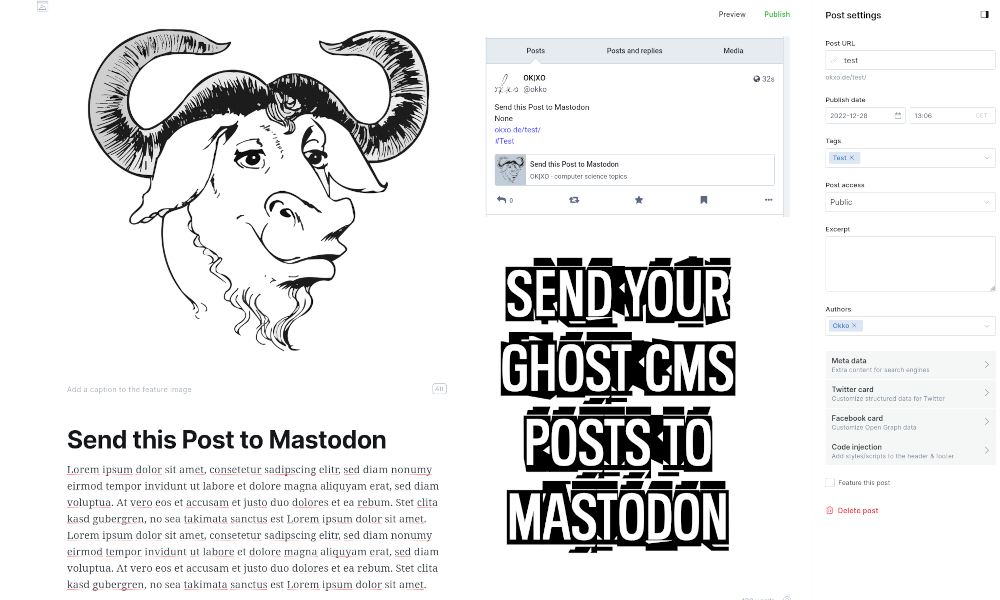Send posts from GhostCMS to Mastodon.
Ghost CMS triggers new posts and sends a webhook with the new post to a local Python Flask instance.
The Flask script fetches the relevant data from the payload and creates a Mastodon post.
We use Mastodon.py for this.
The Flask script is secured by UWSGI and access control.
As a bonus, GhostCMS tags are converted to Mastodon hashtags.
- Once set up completely automated
- Restricting access to trusted IPs
- Encrypted transmission to Mastodon
- Respecting Mastodon policies (no excessive ping queries, avoiding SPAM, etc.)
- Extensive debugging
By default, the webhook endpoint should not be accessible from outside.
Access to the webhook is unencrypted, because GhostCMS does not allow access (without major intervention) to self-signed certificates.
If you are not running the instance on the same server as Ghost CMS, you need to encrypt the connection via https (e.g. using a reverse proxy).
Your GhostCMS must then be added to the trusted proxies list in .env
- Mastodon access token
- Custom integrations webhook in Ghost CMS
- You need to add secrets to .secure folder or pass the secrets via docker run
The only check you need to set is at "write:statuses".
Leave all others unchecked!
This container does not use any other settings and therefore does not need any other permissions!
http://dockerIP:5000/webhook
You can of course change this port via Docker or in the source code.
If you are using the docker compose setting with fixed ip, that would be the IP 10.9.9.99
On bare metal installations it would be localhost/127.0.0.1.
The settings in Ghost CMS are done via custom integrations.
The event trigger is "Post published
Secrets are parsed to the folder .secrets in your docker folder:
.
├── docker-compose.yml
├── .secrets
│ ├── MASTODON_ACCESS_TOKEN
│ ├── MASTODON_BASE_URL
│ ├── TRUSTED_PROXIES
│ └── WEBHOOK_SECRET
Populate the files in the .secrets directory as follows:
Copy your Mastodon token to MASTODON_ACCESS_TOKEN.
Copy your Webhook token from Ghost CMS to WEBHOOK_SECRET.
Enter in MASTODON_BASE_URL the address of your Mastodon instance, e.g. https://mastodon.social .
At TRUSTED_PROXIES you enter a list of IPs that should have access to your webhook instance.
By default, only localhost and access via Docker subnet from the Docker compose example is entered with a fixed IP, i.e. 10.9.9.0/24.\
docker run -d -p 5000:5000/tcp \
-v "${PWD}/.secrets/WEBHOOK_SECRET:/run/secrets/WEBHOOK_SECRET:ro" \
-v "${PWD}/.secrets/MASTODON_ACCESS_TOKEN:/run/secrets/MASTODON_ACCESS_TOKEN:ro" \
-v "${PWD}/.secrets/MASTODON_BASE_URL:/run/secrets/MASTODON_BASE_URL:ro" \
-v "${PWD}/.secrets/TRUSTED_PROXIES:/run/secrets/TRUSTED_PROXIES:ro" \
--net webhookSubnet \
--ip 10.9.9.99 okxo/ghostcms2mastodon
version: '3.1'
secrets:
WEBHOOK_SECRET:
file: ${PWD}/.secrets/WEBHOOK_SECRET
MASTODON_ACCESS_TOKEN:
file: ${PWD}/.secrets/MASTODON_ACCESS_TOKEN
MASTODON_BASE_URL:
file: ${PWD}/.secrets/MASTODON_BASE_URL
TRUSTED_PROXIES:
file: ${PWD}/.secrets/TRUSTED_PROXIES
services:
ghostcms2mastodon:
image: okxo/ghostcms2mastodon:latest
restart: always
ports:
- 127.0.0.1:5000:5000
secrets: [WEBHOOK_SECRET,MASTODON_ACCESS_TOKEN,MASTODON_BASE_URL,TRUSTED_PROXIES]
environment:
WEBHOOK_SECRET: /run/secrets/WEBHOOK_SECRET
MASTODON_ACCESS_TOKEN: /run/secrets/MASTODON_ACCESS_TOKEN
MASTODON_BASE_URL: /run/secrets/MASTODON_BASE_URL
TRUSTED_PROXIES: /run/secrets/TRUSTED_PROXIES
networks:
vpcbr:
ipv4_address: 10.9.9.99
tty: true
networks:
vpcbr:
driver: bridge
ipam:
config:
- subnet: 10.9.9.0/24
gateway: 10.9.9.1
You need to enter a fixed ip for the docker container.
docker compose up -d
Create an upstream in /etc/nginx/nginx.conf
upstream mastodonwebhook {
server 127.0.0.1:5000;
keepalive 64;
}
Add webhook location to your GhostCMS NGINX conf (in sites-availabe or in conf.d folder):
location /webhook {
proxy_set_header Host $host;
proxy_set_header X-Real-IP $remote_addr;
proxy_set_header X-Forwarded-For $proxy_add_x_forwarded_for;
proxy_set_header X-Forwarded-Proto $scheme;
proxy_set_header X-Forwarded-Host $http_host;
proxy_set_header X-Forwarded-Uri $request_uri;
proxy_set_header X-Forwarded-Ssl on;
proxy_redirect http:// $scheme://;
proxy_http_version 1.1;
proxy_set_header Connection "";
proxy_cache_bypass $cookie_session;
proxy_no_cache $cookie_session;
proxy_buffers 64 256k;
# If behind reverse proxy, forwards the correct IP
set_real_ip_from 10.0.0.0/8;
set_real_ip_from 172.0.0.0/8;
set_real_ip_from 10.9.0.0/16;
set_real_ip_from 192.168.0.0/16;
set_real_ip_from fc00::/7;
real_ip_header X-Forwarded-For;
real_ip_recursive on;
proxy_pass http://mastodonwebhook;
}
Restart Nginx.
Dependencies are in pyproject.toml
apt install python3-dev python3-venv \
pip3 install -r requirements \
python3 -m venv webhook && source webhook/bin/activate \
cd webhook \
cp Pythonfiles and ini files to your webhook folder \
export MASTODON_ACCESS_TOKEN='**Add_your_Access_Token_Here**' \
export MASTODON_BASE_URL='**https://Add_your_Mastodon_URL_Here**' \
export TRUSTED_PROXIES='**LIST of IPs with access to local webhook endpoint**'\
start uwsgi server:
uwsgi --socket 127.0.0.1:5000 --protocol=http -w wsgi:app
This project uses https://github.com/halcy/Mastodon.py and would not be feasible without this advance work.
Licensed under the terms of GNU General Public License v3.0. See LICENSE file.
